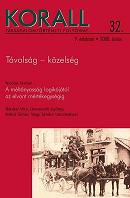A háznép Nagyszombatban (1579–1711). Család és háznép az átmenet előtti Európa városaiban
Household in Nagyszombat (1579–1711) Family and household in Europe before the demographical transition
Author(s): György GranasztóiSubject(s): History
Published by: KORALL Társadalomtörténeti Egyesület
Summary/Abstract: In anthropological sense, ‘household’ used to be the cellular comparative unit of the urban structure of towns before the demographic transition. All those who lived under the same roof as the first man of a house were considered to belong to one household. This is the conclusion of the systematic analysis of a town’s society based on tax registers or censuses prepared by townspeople. Since the registrars, to be able to assess taxes as precisely as possible, progressed from house to house asking several questions, the sixteenth-eighteenth-century tax registers of the town of Nagyszombat (present-day Trnava, Slovakia) function as quasi-surveys. Since essentially the same questions were repeated each time, we now have a unique source for the history of the town conceived at five different times (1579, 1612, 1634, 1656, 1711). These sources can be used not only to trace the stratification of the town’s society, but a transformation of the use of the social space can be detected at the same time too. The composition of urban households was diverse in Early Modern Europe. Understanding this is crucial for historians, since it makes learned conclusions about characteristics of family structure possible. The fragmentary nature of the conclusions about family demographics is counterbalanced by the fact that the sources cover five different points in time. The analysis focuses on those individuals in the tax register, who were designated by the term ibidem. In modern terms, whereas the head of the household is considered ‘primary occupant’, ibidem simply means ‘occupant’. Some of them paid taxes after themselves; some were levied taxes after their paid work. In Nagyszombat, the majority of ibidems usually lived in districts with higher house taxes. The difference in the size of households also represents social differences, which affected the way social space was structured. This function, however, changed significantly through the respective years. The indepth analysis of the composition of large households concluded that the signify cance of more complex family nuclei cannot be ignored. This view dissents from earlier scholarship of urban history. Data from the crisis-ridden years of 1634 and 1656 suggest that the ties keeping together larger households were not strong and their cohesion was usually encouraged by economic prosperity rather than anything else. Parallel to this, in some cases it seems that larger households of primary occupants with Slavic surnames stayed together even in humbler financial circumstances. Due to the changes in the circumstances of the formation of large households, the transformation of consumer habits in the seventeenth century developed a new concentration of these households near the market square of the town. From the aspect of social history, one of the general conclusions of the analysis of households was that phenomena were not linear but interrelated.
Journal: Korall - Társadalomtörténeti folyóirat
- Issue Year: 2008
- Issue No: 32
- Page Range: 5-30
- Page Count: 26
- Language: Hungarian

